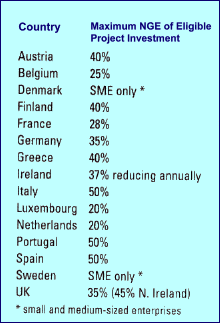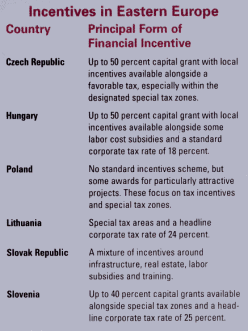
E |
conomic slowdown and uncertainty is increasing pressure on companies to improve margins. Within Europe, one response of multinational corporations has been to initiate cost reduction through consolidation/rationalization /relocation projects of both manufacturing and service activities.
Government financial incentives are available for these projects (as well as typical new/greenfield investments) and can be particularly beneficial in offsetting transition costs. The levels of support can be significant — up to 50 percent of fixed capital invested in some European countries. However, obtaining incentives for these rationalization projects is more complex, not least due to the sensitivities of being associated with job losses elsewhere and the possibility of being accused of “social dumping”.
Incentives Across Europe
Each European Union (EU) country still operates its own system of incentives, and while most central and eastern Europe nations were initially anti-state aid, they have recently introduced a range of primarily tax-driven incentives. All share a common objective of seeking to encourage investment to less prosperous regions.
Last year, most EU countries had their Regional Aid maps and schemes reviewed, resulting in a reduction in geographic coverage and the maximum level of aid. This regional map has maintained a two-tier system across the EU. In priority areas, grant aid must not exceed 50 percent of “eligible project expenditure”; in the lower priority areas the maximum is 20 percent. Individual countries, however, are free to set local limits within these levels, so there is no uniform picture. Also, what constitutes eligible project expenditure can also be open to interpretation and local flexibility.
The level of grant aid is generally quoted as Net Grant Equivalent (NGE). This refers to the proportion of grant provided as a proportion of discounted eligible capital expenditure involved in the project. Although not directly affecting central and eastern Europe, these countries are generally following this approach as they move toward EU membership.
While the EU measures financial incentives in terms of direct contribution against capital expenditure, many member states have measured the value for money of their contribution in terms of amount per job. Other member states have sought to use fiscal measures to give advantage in seeking to attract inward investment. These measures were outside the jurisdiction of the EU until 2000.
The actual impact of fiscal arrangements can only be considered on a case-by-case basis, since they will depend on group structures, profitability and flows of any profits made. In addition, there are a wide variety of schemes for assisting small and medium sized enterprises, which are not considered in this article.
Principal Forms of European Financial Incentives:

Generally a cash grant or tax credit. Calculated on the project being undertaken and linked to the eligible capital spend. Typically governments link this to an amount per job, created often as a “value for money” indicator.
Locally provided funds often offset against local property tax or linked to jobs created. Diminishing as an incentive and generally not material to location selection.
Incentives around the provision of subsidised land, infrastructure costs, advance factories or meeting exceptional site reclamation costs. Also includes gap funding, where investment is greater than market value. Often forms part of the NGE calculation within the EU.
Subsidies provided to meet initial salary costs of long term unemployed or subsidies against social security costs of employees (typically lasting 6-12 months).
Funds provided to meet a proportion of the initial training/retraining costs of the employer. Sometimes pre-employment training costs provided free to the employer.
Grants available to meet eligible R&D costs where the product falls within priority sectors and is involved in pre-market research.
Areas where special corporate tax rates, writing down allowances or duty concessions may be gained.
Headline reductions in corporate tax rates, which should be examined against expected profitability, policy against profit repatriation and group tax structures.
Trends & Future Developments
The proportions of financial incentives available are being reduced across Europe. Even in the traditionally high grant areas, such as Ireland, a reducing scale of assistance has been agreed for the next five years. The eastern states of Germany have a capped limit of 35 percent while the Netherlands now has no higher level areas of assistance. The application to join the EU has caused the Czech Republic to align its State Aid regulations.
Historically, incentives have been awarded for any job-creating projects with little concern for quality and sustainability. Exceptionally, however, specific incentive regimes have influenced industry structure such as the low corporate tax rates attracting pharmaceutical production in the Republic of Ireland. As pressure is placed on State Aid limits and as European countries move toward increased planning of their economic development, grants will become more targeted. Western European countries are seeking to develop schemes, which will attract higher value added projects.
As grants become more scarce and closely linked to nature of the activity, understanding development agency/government drivers will be critical to maximizing the incentives available.
Continue to: Canada’s Business Climate Beckons Investors

